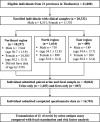Large-scale epidemiology of opisthorchiasis in 21 provinces in Thailand based on diagnosis by fecal egg examination and urine antigen assay and analysis of risk factors for infection
- PMID: 40668872
- PMCID: PMC12313068
- DOI: 10.1371/journal.pntd.0013095
Large-scale epidemiology of opisthorchiasis in 21 provinces in Thailand based on diagnosis by fecal egg examination and urine antigen assay and analysis of risk factors for infection
Abstract
Introduction: Infection with the carcinogenic fish-borne trematode Opisthorchis viverrini, known as opisthorchiasis, is a major cause of biliary cancer (cholangiocarcinoma). Despite decades of disease prevention and control in Thailand, the parasite remains endemic. Here we apply a novel antigen assay for mass screening of opisthorchiasis and compare the prevalence against the conventional examination and analyze risk factors associated with current O. viverrini infection.
Materials and methods: We conducted a large-scale cross-sectional survey to assess transmission of O. viverrini in the North, Northeast, and Eastern regions of Thailand. We screened randomly selected people (age 15 years and over) in 23 sub-districts, within 21 provinces, with a target sample size of 1,000 per sub-district. Each participant was screened for multiple helminth infection by fecal examination (quantitative formalin-ethyl acetate concentration technique; FECT), and the antigen assay by monoclonal antibody-based enzyme-linked immunosorbent assay (ELISA) was applied to urine samples to detect O. viverrini. We collected risk factors for O. viverrini infection using standardized questionnaire surveys. The data were analyzed with regression models which correlated individual-level explanatory variables against i) infection status with O. viverrini and ii) the intensity of infection, as measured by the antigen assay or FECT.
Findings: Of the 20,322 individuals enrolled, 19,465 provided urine samples for antigen detection by ELISA and 18,929 provided fecal samples for examination by FECT. The urine antigen assay revealed an overall opisthorchiasis prevalence of 50.3%, a fourfold increase over the 12.2% prevalence detected by FECT. Marked spatial heterogeneity was observed, with antigen-based prevalence estimates ranging from 22.2% to 71.4% and several localities exceeding 60%. When assessed against a composite reference standard (combined ELISA and FECT), the urine ELISA yielded a diagnostic sensitivity of 91.6%, compared with 21.9% for FECT. We found a positive correlation between fecal egg counts and the concentration of worm antigen in urine across study sites. The ratio between the prevalence of O. viverrini observed by the antigen assay and FECT was high in provinces with a low mean number of O. viverrini eggs, and the ratio approached unity as the mean eggs per gram of stool (EPG) increased. Similar aggregate distribution patterns of fecal egg counts (EPG) and urine antigen concentrations suggest that the urine assay has potential for quantitative diagnostic evaluations. When analyzing individual-level risk factors, we further identified age, sex, occupation, a history of prior treatment with praziquantel, history of O. viverrini examination, and raw fish consumption as predictive of infection with O. viverrini, while a higher education level and certain occupations emerged as protective factors.
Conclusions and recommendations: Application of the antigen assay to diagnose O. viverrini infection yielded a four-fold higher prevalence than the fecal egg examination, with the highest difference in low endemicity regions, which suggests that previous surveys may have underestimated the extent of opisthorchiasis in Thailand. Given the ease of urine sample collection, our study highlights the potential for application of the antigen assay as a new tool in the control of opisthorchiasis.
Copyright: © 2025 Kopolrat et al. This is an open access article distributed under the terms of the Creative Commons Attribution License, which permits unrestricted use, distribution, and reproduction in any medium, provided the original author and source are credited.
Conflict of interest statement
The authors have declared that no competing interests exist.
Figures






Similar articles
-
Comparing the performance of urine and copro-antigen detection in evaluating Opisthorchis viverrini infection in communities with different transmission levels in Northeast Thailand.PLoS Negl Trop Dis. 2019 Feb 8;13(2):e0007186. doi: 10.1371/journal.pntd.0007186. eCollection 2019 Feb. PLoS Negl Trop Dis. 2019. PMID: 30735492 Free PMC article.
-
Advances in the Diagnosis of Human Opisthorchiasis: Development of Opisthorchis viverrini Antigen Detection in Urine.PLoS Negl Trop Dis. 2015 Oct 20;9(10):e0004157. doi: 10.1371/journal.pntd.0004157. eCollection 2015. PLoS Negl Trop Dis. 2015. PMID: 26485024 Free PMC article.
-
Thinking beyond Opisthorchis viverrini for risk of cholangiocarcinoma in the lower Mekong region: a systematic review and meta-analysis.Infect Dis Poverty. 2018 May 17;7(1):44. doi: 10.1186/s40249-018-0434-3. Infect Dis Poverty. 2018. PMID: 29769113 Free PMC article.
-
Effects of day-to-day variation of Opisthorchis viverrini antigen in urine on the accuracy of diagnosing opisthorchiasis in Northeast Thailand.PLoS One. 2022 Jul 19;17(7):e0271553. doi: 10.1371/journal.pone.0271553. eCollection 2022. PLoS One. 2022. PMID: 35853022 Free PMC article.
-
The effect of sample site and collection procedure on identification of SARS-CoV-2 infection.Cochrane Database Syst Rev. 2024 Dec 16;12(12):CD014780. doi: 10.1002/14651858.CD014780. Cochrane Database Syst Rev. 2024. PMID: 39679851 Free PMC article.
References
MeSH terms
Substances
Grants and funding
LinkOut - more resources
Full Text Sources
Medical

